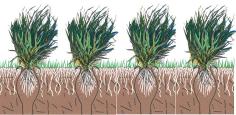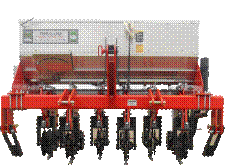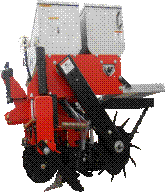

|
Chinese Red Cow Peas In Bahia Grass |

|
Tarver Sales · Folsom, LA 70437 · 800-848-9303 |

|
Every 12 inches, a perfect seed bed of ground-up roots and soil is created, 1˝ to 2 inches wide at the surface and 3 inches wide below the surface and an average 5˝ inches deep. The remaining sod is nourished with fertilizer and water traveling out from these seed beds and meeting between the rows. It has been seen that the sod flourishes while allowing interseeded plants/crops to utilize the benefits provided by living sod. In this system, very little, (if any), chemicals are needed. Only one trip is required to create the seed bed, plant the seed and place the fertilizer deep under the seeds and under the roots of the sod grass. (A substantial saving compared to conventional multiple trip farming.) Erosion and fertilizer pollution is eliminated or greatly reduced. Destruction of living, producing sod is eliminated. The Plant-O-Vator® system working with nature enhances the sod and provides an opportunity to at least double the production by double-cropping. While the sod flourishes from the “Plant-O-Vating”, it is continuously building up the soil’s nutrients (reducing need for commercial fertilizer), reducing nematode activity, controlling weeds and perhaps insects. What helps make this possible? In the 5˝ x 3 x 2-inch seed bed area, the grasses’ roots are totally ground up and incorporated into the soil/seed bed. The competition is thereby removed sufficiently enough for the interseeded crop to establish and grow. |
|
with the plant-o-vator® system, the sod is never destroyed. |

|
Deep fertilizer placement zone encourages deep root system |


|
Mini seed beds (5˝ inches deep, 3 inches wide and 12 inches apart) also become reservoirs for water storage. |
|
Undisturbed area of perennial grasses flourish with this “cultivation”, fertilizer, water and resulting organic, humus buildup. |



